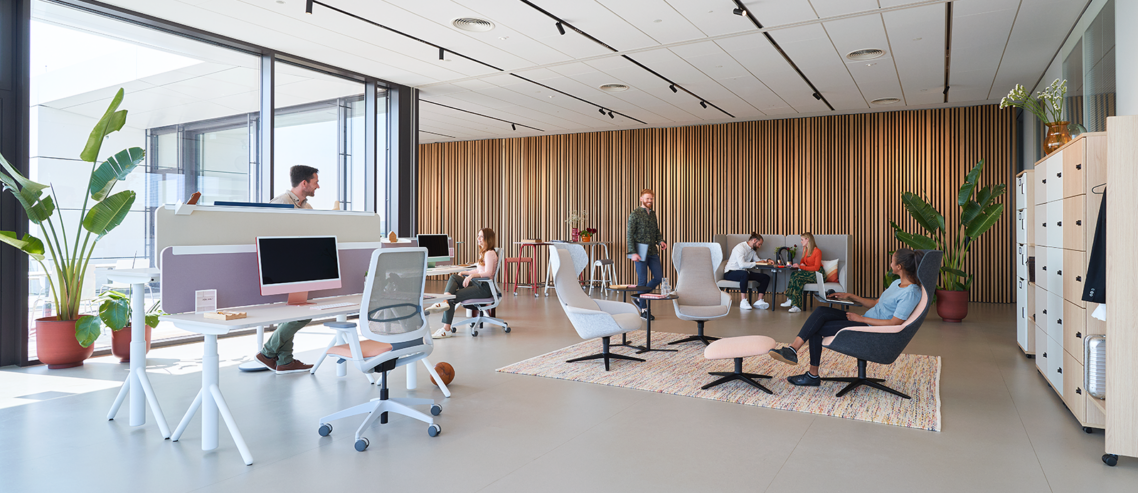Ergonomic Furniture: The Key to Workplace Wellness and Productivity
You’ve likely heard the term “ergonomic furniture” tossed into conversations around the office. But how does it differ from every other kind of furniture? We’ll go over the basics of what makes furniture ergonomic and why it’s a useful addition to any workplace.
Ergonomic furniture is designed to be supportive, functional, and comfortable for the human body. It effectively reduces the risk of musculoskeletal problems and repetitive motion injuries. Ergonomic furniture should also accommodate many different body types. Knowing this, would you say that you work in an “ergonomic office?”
The benefits of ergonomic furniture
Ergonomic office furniture helps maintain your physical and mental well-being while you work. It can reduce stress and pressure, particularly on your spine, neck, legs, and arms. A comfortable work environment can boost productivity and reduce workplace injuries and stress.
Sit-stand desk
Sit-stand desks are one of the best compromises between a sitting desk and a standing desk. This is because healthy movement is one of the most important factors in ergonomics. When the dangers of an excessively sedentary lifestyle became a hot topic, trends in office ergonomics shifted toward all-day standing. This may have been a step in the right direction. However, newer research indicates that standing in the same position for long periods can be equally detrimental to workers’ health.
According to research conducted at the University of Waterloo, the ideal daily sit-stand ratio is between 1:1 and 1:3.1 A height-adjustable desk allows you to seamlessly transition from a sitting position to a standing position throughout the day.
Ergonomic chair
What makes a chair “ergonomic?” Well, an ergonomic chair has several features that enable its user to maintain proper posture when they’re using it. The first is an adjustable seat height.
This allows the user to adjust the chair to their own height. An ergonomic chair should mold naturally with the curvature of the spine and upper body, providing lumbar support. When using an ergonomic chair, your feet should be flat on the floor and your knees at a 90-degree angle. Ergonomic chairs also provide adjustable arm support, backrest angle adjustment, proper seat width, neck support, and seat depth adjustment. One of the keys to ergonomics, however, is making sure you sit correctly while using the chair. An ergonomic office chair is only as effective as how the user engages with it.
Ergonomic stool
This relatively new and innovative office seating provides the perfect compromise between sitting and standing. If you prefer to stand and just need a place to occasionally rest, an ergonomic stool is an excellent solution. An ergonomic stool allows secure movement while you sit on it. It also has proper padding on the seat and ideally has sloping edges, to ensure circulation in your legs. Most ergonomic stools have a rounded base. This allows the user to slightly adjust and move their body without losing their balance. They’re also great for smaller or dynamic spaces where you don’t have room to store an ergonomic chair.
Kneeling chair
These dynamic, alternative kneeling seats hit the market in 1979 when Norwegian designer Hans Christian Mengshoel unveiled them.2 Instead of a traditional chair with feet flat on the floor, your knees bend with your heels below your torso. A proper kneeling chairlowers the angle of the lower body, keeping the spine and pelvis open. At this position, if one leans inward, the body angle remains 90° or wider. Depending on your height or task at hand, being able to adjust the kneeling chair’s height is an important consideration.
Monitor arms
If you’re unable to raise your desk to an ideal ergonomic height, one practical option is an adjustable monitor arm. This is a robotic or mechanical mechanism that allows you to move your laptop or monitor to different levels. The monitor height should be that the top of the screen is level with or slightly below eye level. This helps prevent neck pain that arises from holding your head in an unnatural position for extended periods.
Anti-fatigue mats
If you prefer standing at work or transition between sitting and standing, you may benefit from an anti-fatigue mat. Anti-fatigue mats can reduce fatigue caused by standing for long periods on a hard surface. Fatigue-reducing mats can be made of various materials. These mats are often used to decrease foot and lower-limb disorders for workers who extensively stand in one position.
When it comes to anti-fatigue mats, softer and thicker may not always be better. Choose a mat that provides some elasticity but is not so soft that you can’t stand comfortably. Know the environment the mat will be used in, and make sure it doesn’t create a tripping hazard.
Choosing the Right Ergonomic Furniture
While ergonomic furniture is a staple in working environments, that’s not the only place it’s helpful. You can also use the same principles of ergonomics at home with high-quality ergonomic furniture. Whether you’re setting up an office workstation or trying to maintain good posture at home, ergonomic furniture is key. Fortunately, Sedus has plenty of ergonomic chairs and other products that empower workers to stay happy, healthy, and productive. Contact them to find out how you can upgrade your office furniture with stylish, dynamic, ergonomic solutions.
1 How long should you stand — rather than sit — at your work station?
